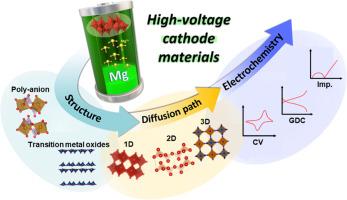可充电镁电池用高压正极材料:结构方面和电化学观点
IF 13.8
1区 材料科学
Q1 METALLURGY & METALLURGICAL ENGINEERING
引用次数: 0
摘要
可充电镁电池(RMBs)是一种尖端的能量存储解决方案,与最先进的锂离子电池(lib)相比,它有几个优势。与目前用作锂离子电池阳极材料的石墨相比,使用镁(Mg)金属作为阳极材料提供了更高的重量容量。尽管在电解质方面取得了重大进展,但阴极材料的发展仅限于在低平均放电电压(<1.0 V vs. Mg/Mg2+)下工作的材料,而开发高压阴极仍然具有挑战性。只有少数材料被证明可以在高压下可逆地插入Mg2+离子。本文综述了高压阴极材料的结构方面,包括与其电化学性能相关的Mg2+嵌入机制。将材料分为过渡金属氧化物和聚阴离子,并根据Mg2+的本征扩散路径进行分类。这篇综述还提供了对每种材料未来发展的见解,旨在激励和指导在该领域工作的研究人员朝着高压阴极的进一步发展。本文章由计算机程序翻译,如有差异,请以英文原文为准。

High voltage cathode materials for rechargeable magnesium batteries: Structural aspects and electrochemical perspectives
Rechargeable magnesium batteries (RMBs) are a cutting-edge energy storage solution, with several advantages over the state-of-art lithium-ion batteries (LIBs). The use of magnesium (Mg) metal as an anode material provides a much higher gravimetric capacity compared to graphite, which is currently used as the anode material in LIBs. Despite the significant advances in electrolyte, the development of cathode material is limited to materials that operate at low average discharge voltage (<1.0 V vs. Mg/Mg2+), and developing high voltage cathodes remains challenging. Only a few materials have been shown to intercalate Mg2+ ions reversibly at high voltage. This review focuses on the structural aspects of cathode material that can operate at high voltage, including the Mg2+ intercalation mechanism in relation to its electrochemical properties. The materials are categorized into transition metal oxides and polyanions and subcategorized by the intrinsic Mg2+ diffusion path. This review also provides insights into the future development of each material, aiming to stimulate and guide researchers working in this field towards further advancements in high voltage cathodes.
求助全文
通过发布文献求助,成功后即可免费获取论文全文。
去求助
来源期刊

Journal of Magnesium and Alloys
Engineering-Mechanics of Materials
CiteScore
20.20
自引率
14.80%
发文量
52
审稿时长
59 days
期刊介绍:
The Journal of Magnesium and Alloys serves as a global platform for both theoretical and experimental studies in magnesium science and engineering. It welcomes submissions investigating various scientific and engineering factors impacting the metallurgy, processing, microstructure, properties, and applications of magnesium and alloys. The journal covers all aspects of magnesium and alloy research, including raw materials, alloy casting, extrusion and deformation, corrosion and surface treatment, joining and machining, simulation and modeling, microstructure evolution and mechanical properties, new alloy development, magnesium-based composites, bio-materials and energy materials, applications, and recycling.
 求助内容:
求助内容: 应助结果提醒方式:
应助结果提醒方式:


